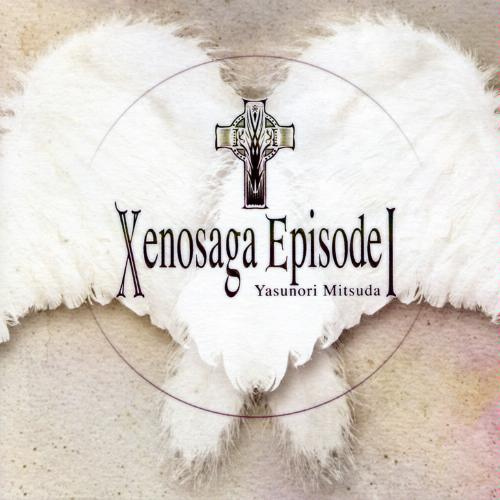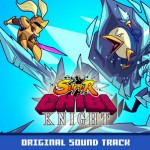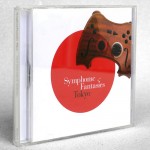…And now for something almost completely different. When I write a review for a soundtrack, it is usually quite new and my main aim is to inform you, dear readers and fellow nerdiophiles, why I think this ‘new’ thing is worth your hard-earned cash. I often haven’t played the game associated with it, and so my reviews are notoriously ‘out of context.’ Typically I only review things I expect to like, too – simply because I’m more likely to give them the attention they deserve from a reviewer. Conversely, things I don’t like I leave to others to praise or criticize – and often in the process come to see I was if not wrong then at least too quick to judge or not listening with the right ears, if you will.
The Soundtrack of the Month feature isn’t burdened by that onus to ‘judge.’ It is my chance to say, hey, this is my favorite game soundtrack and this is why. If we used a numerical rating system, the SOTM would be an automatic 10/10. I’m going to assume some if not most of you have heard the work of Yasunori Mitsuda, whether it’s well-known stuff like Chrono Trigger or Xenogears or slightly more obscure things like KiRite or Tsugunai: Atonement.
While I really dislike it when people pick easy targets, I’m about to shoot fish in a barrel, sing to the choir and go on a duck hunt with a bazooka. This is my paean to the soundtrack of one of my favorite games, Xenosaga Episode 1: Der Wille zur Macht. Spoilers ahead! – yep, I’m going tell you about more than just the music this time. Now I bet you just want to know…
…How I’m going to approach this. Let’s start with the basics. Xenosaga Episode 1 by Namco Bandai was a 2002 Sci-Fi RPG for the PS2 that featured enough giant mecha, Judeo-Christian symbolism and psychological depth to make Neon Genesis Evangelion blush. It preferenced story over gameplay in an era when many gamers seemed to be losing a taste for the turn-based. As the spiritual successor to Squaresoft’s Xenogears, Xenosaga had a lot to live up to and in some ways failed. The series was sliced in half half-way, the gameplay mechanics went through some radical overhauls between games and the convoluted plots, sub-plots and sub-sub-plots were just not what gamers of the 21st century seemed to want. But back in 2002, Xenosaga Episode 1 was a promise of hope and ambition, and its soundtrack wasn’t just a part of that – it was almost a deciding factor. It remains Mitsuda’s crowning achievement. You can find numerous fan arrangements of Chrono Trigger, Chrono Cross and Xenogears, but somehow Xenosaga defies such ‘improvements.’ The man’s name appears first in the opening credits – testament to just how intrinsically significant the music of Xenosaga is to its other elements.
Although I can and will be speaking of these tracks as inexorably linked (in my mind) with the context, Mitsuda himself rearranged the order of the re-released CDs, with the first being ‘live’ performances and the second synthesized. The artists for disc 1 are credited extensively in the booklet; disc 2 receives merely a track list. I use ‘merely’ lightly, because it still has some of the best moments of the album. But we’ll come to that in good time.
The first disc has been favorably compared to movie soundtracks, and with the London Philharmonic on board, it’s little wonder. Despite that, it starts with a piano rendition of Shion’s theme, which captures her uncertainty and longing in the simplest and most direct manner. The theme also spikes several other tracks: when played on synth strings and harp, it happens to be ‘Game Over’; ‘The girl who closed her heart’ presents it like a requiem; and ‘Shion ~ Emotion~’ iterates it at a higher pitch. ‘Nephilim’ and ‘Warmth’, while also being primarily piano pieces, are quite clearly differentiated from this otherwise pervasive theme.
‘Prologue’ and ‘Gnosis’, to move onto the London Philharmonic contributions, are as full and explosive as orchestral music gets, as well they should be. ‘Prologue’ announces a giant 2001-esque monolith, the Zohar, rising from the waters; ‘Gnosis’ is a terrifying invasion of invincible, non-corporeal aliens that (very symbolically) turn anything they ‘touch’ to salt. ‘Life or Death’ from disc 2 leads into the Gnosis invasion below. Have a listen and see if you can hear something missing from ‘Gnosis’, something we almost habitually attribute to the notion of ‘epic.’
Of the many companies and societies to lurk in Xenosaga’s universe, U-TIC is the most obviously militant organization. You could march to its foreboding theme but if so, it’d be the heavily-armored stride of clerics into battle. On an album less dedicated to quality, ‘Prologue’, ‘Gnosis’ and ‘U-TIC Facility’ strung together would be overkill and imbalanced, but here just whet the palate. Three other tracks feature the virtuosity of the London Philharmonic and the Metro Voices, and each deserves special mention. ‘Zarathustra’ (namesake of the third game and final boss of the entire trilogy) opens with pipe organ not unlike a Castlevania piece but then moves through strings, orchestra and choir, punctuated by the haunting countermelody of Eurovision winner Eimear Quinn. The next track is absolutely and by far-and-away my favorite. ‘Ω’ plays late in the game and accompanies the arrival of the cavalry: Vector Industries’ planet-sized flagship, the Dämmerung (the ‘Twilight’ part of Wagner’s ‘Twilight of the Gods’). This is, to my knowledge, one of the first examples of orchestra, choir and electric guitar working together in a video game OST, and it’s just amazing. Echoes of ‘Gnosis,’ ‘U-TIC Facility’ and ‘Prologue’ are bolstered by the snare drum and guitar riffs. Yet not once does it feel like a fusion or arrangement, and I think this unforced chemistry is the real wonder of ‘Ω.’ Finally, ‘Escape’ follows the ‘Gnosis’ invasion and is my least-preferred of the ‘live orchestral’ pieces, but only in light of the superiority of the others.
If U-TIC is the fist, the a capella hymn of the organization’s spiritual core, ‘Ormus,’ is the faith, the foundation. Another a capella piece, ‘Resurrection’, would easily pass for ‘authentic’ Gregorian chanting; ‘The Miracle’ adds an understated orchestra to the ‘Resurrection’ chant to present Xenosaga’s tribute to Gloria in Excelsis Deo. All three are choir done right: you might not know the terms, but you can tell the melisma from the doxologia nova, the cantus inferior from the cantus superior. Someday soon I’ll translate the lyrics in the booklet (I’m sure they exist online somewhere, but I’m a hands-on kinda guy), but what is of concern here is how well Mitsuda utilizes the various parts of a choir to their maximum potential, not just a loud, heavy-handed chorus proclaiming, ‘END BOSS! Hope you leveled up!’
Also rather pared-down is ‘Beach of the Void’ by the Kuwano Hijiri Strings. What I love most about this piece is it cleverly blends the theme of ‘Gnosis’ with the threat of ‘Proto-Merkabah’ and thus foreshadows the final battle. Less clever is the rendition of ‘Greensleeves,’ but thanks to its ponderous nature, it still doesn’t remind me of ice-cream. ‘World to be Born’ never featured in the game but is a work of which Mitsuda is particularly proud, having finally heard it, along with ‘Gnosis’ and ‘Zarathustra’, performed live at the 2007 Eminence Symphonic Games Edition of ‘A Night in Fantasia’.
Completing the first CD are two songs by Irish songstress Joanne Hogg, who also worked on Xenogears: ‘Pain’ and ‘Kokoro’. Of the two, I like ‘Pain’ more but only because of what it means in-game: this is the song that plays as KOS-MOS, Shion’s android companion with an emerging sentience, sacrifices herself to save the Elsa, main ship of the game’s protagonists, during the game’s epilogue. It could certainly be construed as ‘emo’ out of context but quite delicately conveys how KOS-MOS ‘feels’ towards Shion with lyrics such as, ‘Kindness is something I don’t want or need / the sunshine would just dissolve me into light.’ With that in mind, the piano version just doesn’t quite cut it for me. In comparison, ‘Kokoro’ (‘heart’) sings the very familiar leitmotif introduced by the first track and heard every time Shion has a me-moment (of which there are plenty) or gets slain by the Gnosis (which also happens plenty). It is clearly a love song but, like the bittersweet ‘Pain’, its true significance only becomes apparent when you realize it’s Shion’s way of clinging to her colleague and fiancé Kevin Winicott, whom KOS-MOS murdered in an unexplained ‘rage’ two years before the story. Both songs shine with the Celtic inclinations Mitsuda established with the Xenogears album Creid.
…And that’s just one CD of two. If the first disc is a movie soundtrack, then the second is far more traditionally a game soundtrack, diverse as dictated by the demands of any decent RPG. It is also far more chronologically adherent to the game’s progression. As such, I am not quite so inclined to dwell on each track. There are, however, quite a few highlights.
‘Opening’ sounds a lot like the introduction to Xenogears, ‘Light from the Netherworld,’ and this is no bad thing at all. Moreso than ‘Prologue,’ it has to set the tone for the events about to unfold. And, given the advent of ‘Gnosis,’ ‘Battle’ is inevitable. This is the game’s only battle theme and while some might argue it gets old, I think it does a great job of placing the combat second to the drama: fighting in Xenosaga isn’t meant to be the focus. Incidentally, the music declaring KOS-MOS’ dynamic entrance to the fray, ‘KOS-MOS, fighting’ (I find the other translation ‘Fighting KOS-MOS’ a bit misleading) would make a wicked boss theme, as would the theme for one of the most convoluted antagonists of the series, ‘Margulis’. In fact, I would say the boss theme for Xenosaga Episode III by Yuki Kajiura, ‘Battle for your Soul,’ owes both these tunes quite a lot. And, just like ‘Gnosis,’ neither have a hint of choir.
But, like any good RPG, Xenosaga isn’t all fighting and life-or-death struggles. ‘Everyday’, which plays first when Allen’s co-workers tease him over his crush on Shion, is a jazzy acoustic number you’d expect to hear in an anime during a light-hearted shopping montage. ‘U.M.N. mode’ is the downbeat synth accompanying any access of the in-game computer (which you do a lot, since it also allows you to revisit most areas you’ve already ‘cleared’) and isn’t really designed for listening by itself, but doesn’t hurt. ‘Relief’ and ‘Kookai Foundation’ are triumphant and optimistic respites during which the party finds itself in a haven. ‘Durandal,’ the name of an unsurprisingly sword-shaped ship (commanded by the very short, arrogant and gun-happy ‘Little Master’), is also uplifting, but moreso in intention than actuality: a barrage of lasers against the enemy and then, ‘…let’s give them a little nudge.’
Nearing the game’s climax we have ‘Panic’, the frantic desperation of KOS-MOS standing alone against hundreds of Gnosis, and the downright spooky ‘Song of Nephilim,’ which seemingly summons Gnosis with just four notes, like a perversion of Williams’ famous Close Encounters of the Third Kind five-tone melody. It is with some weird mix of guilt and pride that I admit I noticed it also sounds eerily like a theme used in Buffy the Vampire Slayer. (I can even name the episode. I know. ‘Shame of the Otaku’ indeed.)
The last few tracks definitely rival anything on the first CD. ‘Albedo’ is a white-haired psychopath who, thanks to various plot twists, just keeps popping up as a boss – but his theme is reserved for the cut scenes. I have never heard more fitting music for megalomaniacal madness. Imagine opera armed with a cloak and dagger, where every note of the clarinet becomes sinister and dire; the carefully isolated and yet wildly modulated soprano doesn’t so much send chills down your spine as express-post apprehension to your amygdala. Without such intimate knowledge of Xenosaga, I’d swear from the music that Albedo was the Sephiroth of the series – but it’s so much more complicated than that. He is, at best, a sub-boss, but even that does little justice to the complexity of his relationship to one of the protagonists. ‘Proto Merkabah,’ a starbase designed to merge with the Song of Nephilim, serves as the site of Episode 1’s final confrontation. It is dramatic at both ends of the scale, in turn reminding us of how epic Mitsuda made just two chords with ‘Lavos’ in Chrono Trigger, and then, much closer to the source, reprising the sacred, intimate tone of ‘Zarathustra’ and ‘Ormus.’
Once you make it through Proto-Merkabah, the ‘Last Battle’ awaits. As noted before, every single battle until now has had the same theme, so the impact of hearing anything different is immediate and shocking. The lesson to be learned here is that sometimes you can accentuate something by surrounding it with an absence of itself; in this case, boss themes. And even this ‘Last Battle’ starts small, humble: violin and piano dancing around each other, sounding not unlike Hamauzu’s ‘Assault’ from Final Fantasy X. But then more and more sounds insinuate themselves into the composition: chimes, softened choir, drums, bass guitar, pipe organ – all the while, the violin pushes the piece closer to the inevitable and yet greatly anticipated pinnacle: an evolution of the ‘Gnosis’ leitmotif. Despite all this, I am pleased to say that the ‘Last Battle’, like its predecessor ‘One Who Bares Fangs at God’ from Xenogears, is never bombastic or grandiose; its subtlety and understatement make it all the more potent. By the same token, like many RPG end-bosses in the narrative sense, the fight itself is relatively easy, almost a reward for your hard work thus far. It is in this sense not a climax, but a foregone conclusion, a symbolic expression of the heroes’ stand against a thus-far intangible antagonist. And since it was the end-fight of Episode 1 of a projected 6, even ‘Last Battle’ hints at much bigger things to come — and although musically this might not have been realized, in the grander scope of the series, ‘Last Battle’ is anything but. It is, however, the final track on the album, chosen by Mitsuda to epitomize the grace and dexterity of the soundtrack as a whole.
I’ve often argued that the best soundtracks can be appreciated out of context, so it’s a little hypocritical that I’d treat my favorite almost completely in context. But there is a morsel of insight to be gleaned from this, and it relates to what the Xenosaga Episode 1 album is lacking: character themes. If you’ve played the game, you’ll know I’ve barely scratched the surface regarding the cast, and yet I’ve detailed most of the soundtrack. It is almost purely event-driven; even Shion’s theme is just ‘Kokoro’ retooled. The others, such as ‘Albedo’ and ‘Margulis,’ are the event, not the character — their actions rather than their personality. And not all of the events have music, either: I mentioned absence as a field for accentuation a bit earlier, and several of the cutscenes are silent but for dialogue and sound effects. Contrast this with the 3 or 4 cd monsters that carry the score for certain other RPGs and you can appreciate how poignant the choice to use music or not becomes in a game propelled by storytelling over gameplay. For all its pretension and scope, Xenosaga Episode 1 often revels in its minimalism.
Following this thought, I want to say that if I believe the best soundtracks can be enjoyed on their own, they likely wouldn’t be the best if they didn’t work in context as well. The characters of Xenosaga are events more than anything — vehicles for the narrative, devices for psychological delving. It would be an injustice to allocate them a single theme each or to play any such theme in abundance — something Kajiura recognizes in Episodes II and III, as well. On the other hand, maybe it’d be just too much work to compose unique cues for hours of cutscenes, but the result is the same: a consistently excellent musical offering that augments its context and yet can also create its own.
And so closes my retrospective on one of the most acclaimed game soundtracks ever composed. At this point I hope the main function of this feature was not to sell the album onto you (because you really should have it already) but to give a personal account of why I think it’s so great. And considering it owes so much to Nietzsche, who used chapter titles like ‘Why I am so clever’ and ‘Why I write such good books’ for his autobiography (‘Why I have an awesome moustache’ must have been edited out), I feel that indulging in a little shameless praise of Xenosaga Episode 1’s structural genius and Yasunori Mitsuda’s peerless soundtrack is more than appropriate.
But you may disagree, and I’ve said more than enough. So now it’s your turn. I’m eager to engage with your responses and opinions, not only regarding Xenosaga but anything Mitsuda-related.
Tags: Friedrich Nietzsche, London Philharmonic, metro voices, Monolith Software, Namco Bandai, RPG, Sony PlayStation 2, Soundtrack of the Month, Tetsuya Takahashi, Xenosaga, Yasunori Mitsuda









































Yes to this being the SOTM. Very yes. So much yes. Oh god the yeses.
Also, beast article. Great read.
That’s a very interesting write-up Wes! It was a great read. Since I’m a huge Mitsuda fan, I was quite excited to see this as a Soundtrack of the Month. As for the version you reviewed, I’m much more partial to the original print tracklisting, although this one is nice since it has those bonus themes (World to Be Born is amazing). This is definitely one of those soundtracks where the music is superb, but unfortunately is used poorly, at least in my opinion, during the game. The fact there is only one battle theme throughout the game, until the last boss theme, is also a gripe I had, but overall, it’s a very good soundtrack. I like Xenogears more, particularly for the larger gamut of soundscapes, but this is a worthy successor with a ton of great music (Gnosis, Albedo, and Final Battle) come to mind.
Speaking of “Albedo,” when I first learned that the operatic vocals were just samples, I was absolutely floored. Thought that was a live performance for sure! One of his greatest villain theme compositions to date. It’ll be hard to top that one, I think.
Hey guys, thanks for reading and commenting.
Don, I think were Xenosaga episode 1 to have a soundtrack more proportionate to its cutscenes, battles and explorable areas, it would be reaaally long and far more likely to increase the percentage of mediocre tunes. While certain themes could have been boss battles, I still applaud that they were used more dramatically. In a way, the shortcomings of this soundtrack (implemented poorly, I do agree with this to some extent) can only be noticed if you come at it as a part of the game rather than as a musical creation — an interesting counterpoint to the notion of contextual experience augmenting aural appreciation.
I really like the Xenogears soundtrack as well but at times I feel it rides a little too close to the Chrono series. Xenosaga Episode 1 does so many things I simply would not have attributed to Mitsuda’s range given exposure to the Chronos and ‘Gears.
A quick erratum (I could edit the original, but this is more fun) — the song ‘Pain’ does play during the end sequence, but it is not the Elsa KOS-MOS is saving, but the planet Second Miltia as she sacrifices herself to dismantle Proto Merkabah as it descends towards the planet.
…And yes, I only know this now because I’ve finished rewatching all the cutscenes. Oh, hey, only episodes 2 and 3 to go…